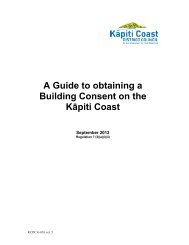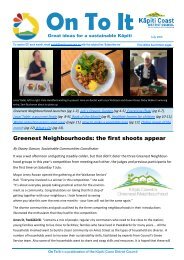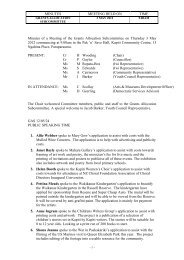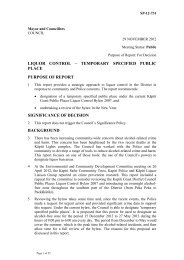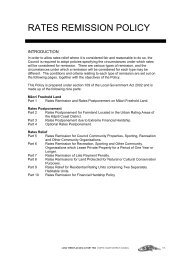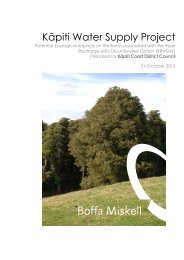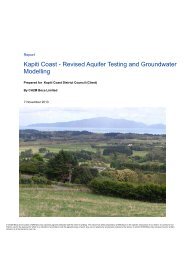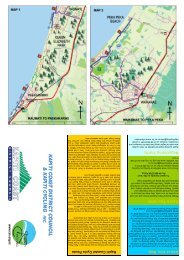waikanae - Kapiti Coast District Council
waikanae - Kapiti Coast District Council
waikanae - Kapiti Coast District Council
You also want an ePaper? Increase the reach of your titles
YUMPU automatically turns print PDFs into web optimized ePapers that Google loves.
HER I TAGE<br />
TRAI LS<br />
<strong>waikanae</strong><br />
For more information visit:<br />
www.kapiticoast.govt.nz/heritage
2<br />
WELcomE To THE KāpITI<br />
coAST HERITAGE TRAIL<br />
The Kāpiti <strong>Coast</strong> has a rich and colourful history. From<br />
Ōtaki in the north, to Paekākāriki in the south, you will<br />
discover sites that played a major role in the cultural,<br />
economic and social growth of New Zealand.<br />
This brochure focuses on Waikanae. It is one of a set<br />
describing some of the significant historical sites in our<br />
district.<br />
For more information please visit<br />
www.kapiticoast.govt.nz/heritage<br />
NAu mAI KI NGā TAKAHANGA<br />
o NGā TāoNGA TuKu IHo o<br />
KāpITI<br />
He kōrero hōhonu tuku iho tō te rohe o Kāpiti. Mai i Ōtaki<br />
ki te raki, ki Paekākāriki ki te tonga, ka tūpono atu koe ki<br />
ngā wāhi i whai take nui ki ngā mahi ā-tikanga, ā-ōhanga,<br />
ā-iwi o Aotearoa.<br />
E arotahi ana tēnei mātārere ki Waikanae. Koinei tētehi<br />
kōwae e whakamārama ana i ētehi o ngā wāhi hira o mua<br />
iho i tō mātou rohe.<br />
Mō ētehi atu kōrero tēnā koa whātoro atu ki tēnei<br />
paetukutuku www.kapiticoast.govt.nz/heritage
KĀpITI<br />
IsLaNd<br />
TO LEVIN<br />
Ōtaki Beach<br />
Te Horo Beach<br />
peka peka<br />
Waikanae<br />
Beach<br />
Raumati<br />
Raumati south<br />
Ōtaki<br />
te HOrO<br />
<strong>waikanae</strong><br />
ParaParaumu<br />
Queen Elizabeth park<br />
Mackays Crossing<br />
Paekākāriki<br />
TO WELLINGTON<br />
3
4<br />
WAImEHA<br />
Opposite 133 Weggery Drive, Waikanae Beach<br />
Waimeha Pā<br />
In 1824 a group of Te Āti Awa iwi arrived from Taranaki<br />
at the invitation of Ngāti Toa. One of their settlements<br />
was on this sandhill overlooking the estuary of the two<br />
rivers. In 1830, Muaūpoko and Rangitāne, the previous<br />
inhabitants of this region, were invited to Waimeha to<br />
try a new food we now call pumpkin. Despite a warning<br />
from some of Ngāti Raukawa they came, but were<br />
killed by Te Āti Awa and Ngāti Toa at the orders of Te<br />
Rauparaha.<br />
Battle of Kuititanga<br />
The battle of Kuititanga took place near this pā site. It<br />
was one of the last intertribal ‘Musket Wars’ before the<br />
signing of the Treaty of Waitangi.<br />
Disputes between Te Rauparaha and his allies, Te Āti<br />
Awa and Ngāti Raukawa, reached boiling point in<br />
1839. On 16 October 1839, Ngāti Raukawa from Te<br />
Horo and Ōtaki attacked Waimeha under cover of<br />
darkness. The defenders withdrew to Arapawaiti, where<br />
reinforcements arrived from the other villages. In a<br />
counter-attack, the Raukawa war party was forced back<br />
to the tribal boundary at Kukutauaki. Te Rauparaha,<br />
who had friends on both sides, watched the fighting<br />
from a whaleboat off shore. The New Zealand Company<br />
ship Tory arrived shortly after the battle. Its surgeons<br />
tended the wounded and, a few days later, a conference<br />
of reconciliation between the two warring factions<br />
was held on board the Tory. In 1848, some Waimeha<br />
inhabitants returned to Taranaki, while the remainder<br />
moved inland to Tuku Rākau.<br />
SITE<br />
1<br />
River scene near this site,<br />
1852 Waikanae, by<br />
Charles Decimus Barraud<br />
Rex Nan Kivell Collection,<br />
National Library of australia
WAImEHA<br />
E hāngai ana ki 133 Huarahi o Weggery, Waikanae<br />
Te Pā o Waimeha<br />
I 1824 i tae mai tētehi tira o te iwi o Te Āti Awa i Taranaki<br />
i runga i te tono o Ngāti Toa. Tētehi o ō rātou kāinga<br />
kei runga i tētehi puke taipū e titiro ana ki te wahapū<br />
o ngā awa e rua. I 1830, ko ngā iwi o mua rā o tēnei<br />
rohe, a Muaūpoko me Rangitāne, i karangatia kia haere<br />
ki te whakamātautau i tētehi kai e kīia ana ināianei<br />
he paukena. Ahakoa te whakatūpato a ētehi o Ngāti<br />
Raukawa, haere tonu mai rātou, ā, i runga i te whakahau<br />
a Te Rauparaha ka patua e Te Āti Awa me Ngāti Toa.<br />
Te pakanga o Kuititanga<br />
I tū te pakanga o Kuititanga i te taha o tēnei pā. Koinei<br />
tētehi o ngā ‘Pakanga Pū’ ā-iwi whakamutunga i mua o<br />
te hainatanga o te Tiriti o Waitangi.<br />
I 1839 kua kinō kē ngā tautohetohe i waenga i ngā<br />
ope haumi a Te Rauparaha, arā, a Te Āti Awa me Ngāti<br />
Raukawa, Nā, i te 16 o Oketopa, i 1839 i whakaekengia a<br />
Waimeha i te pō e Ngāti Raukawa nō Te Horo me Ōtaki.<br />
Ka whati ngā kaiwawao, ka rere ki Arapawaiti, i reira ka<br />
tae mai he ope tānga nō ētehi atu kāinga. Nā te whana<br />
whakairi i hoki whakamuri ai te tauā o Raukawa ki te pae<br />
o te rohe ki Kukutauaki. Nā, he hoa nō Te Rauparaha i<br />
ngā taha e rua, ā, mātakitaki noa ana ia i te whaiwhai mai<br />
i tētehi poti wēra i waho o te moana. Nō muri tata mai o<br />
te pakanga ka tae mai te kaipuke o te Kamupene o Niu<br />
Tīreni, te Tory. Nā ō rātou tākuta i tiaki te hunga taotū, ā,<br />
i ngā rangi tata i muri mai i tū tētehi hui whakahoatanga<br />
i runga i te Tory i waenga i ngā hoariri. I 1848 i hoki atu<br />
ētehi o ngā tāngata a Waimeha ki Taranaki, ko te toenga<br />
i hūnuku ki te tuawhenua, ki Tuku Rākau.<br />
Map of Lower Waikanae<br />
5
6<br />
TuKu RāKAu<br />
In the land between Greenway Road and Puriri<br />
Road. Currently there is no public access to this site.<br />
In 1848 over 600 Te Āti Awa people from the Kāpiti area<br />
returned to their ancestral lands of Taranaki. The villages<br />
that they left behind were damaged by an earthquake<br />
and sand encroachment. Most of the remaining Te<br />
Āti Awa moved to Tuku Rākau, a sheltered and fertile<br />
area just north of Kaiwarehou, a crossing point on the<br />
Waikanae River. Led by Wī Tako Ngātata-i-te-rangi,<br />
they established homes, gardens, a meeting house and<br />
in 1877, a church. Wheat was ground at a flourmill on<br />
the Waimeha Stream and large flocks of sheep were<br />
established. The urupā (burial ground), Takamore, is on<br />
the sand ridge west of this site.<br />
In 1884, at a meeting on the Tuku Rākau marae, railway<br />
company officials met local Māori. Land was given for<br />
the development of the railway, on condition that all<br />
trains stopped at Waikanae. When the line opened for<br />
traffic in 1886, the meeting house, Whakarongotai, was<br />
brought to its present site in Marae Lane.<br />
The house built by L H Greenaway near the corner of Puriri and<br />
Kauri Streets, Waikanae, 1917. The cost of the building was<br />
1,100 pounds on 19 December 1913. It was built of heart rimu<br />
with 12 foot studs<br />
F H Greenaway Collection, alexander Turnbull Library. Ref: ½-080140-F<br />
SITE<br />
2
TuKu RāKAu<br />
Kei te whenua i waenganui i ngā Huarahi o<br />
Greenway me Puriri. I tēnei wa, kāore e wātea<br />
tēnei wāhi ki te hunga tūmutanui.<br />
I 1848 neke atu i te 600 ngā tāngata o Te Āti Awa ki<br />
Kāpiti i hoki atu ki tō rātou whenua tupu ki Taranaki.<br />
Ko ngā kāinga i mahue i a rātou i tūkinotia e te rū, i<br />
auraratia e te one. Ko te nuinga o Te Āti Awa i mahue<br />
iho, i hūnuku atu ki Tuku Rākau, he wāhi taumarumaru,<br />
haumako hoki kei te raki noa o Kaiwarehou, ā, he wāhi<br />
whakawhiti tēnā i te awa o Waikanae. He mea ārahi<br />
rātou e Wī Tako Ngātata-i-te-rangi, ā, he mea whakatū he<br />
kāinga, he māra, he wharenui me tētehi whare karakia i<br />
1877. I kuorotia he wīti i tētehi mira i te taha o te awa o<br />
Waimeha. He hipi rāhui nunui hoki i whakatupungia. Kei<br />
runga tāhuna te urupā Takamore, kei te hauāuru o tēnei<br />
wāhi.<br />
I 1884, i tētehi hui i te marae o Tuku Rākau, i hui tahi te<br />
tira āpiha rerewhenua me te tangata whenua. He mea<br />
tuku he whenua hei whakatupu i te rerewhenua i runga<br />
i te tikanga ka tū ngā tereina katoa ki Waikanae. I te<br />
whakatūwheratanga o te raina hei ara haereere mō te<br />
tangata i 1886, i tōia te wharenui o Whakarongotai ki te<br />
wāhi e tū nei ia ināianei i Marae Lane.<br />
7
8<br />
WHAKARoNGoTAI mARAE<br />
‘Hear the whispering tide’<br />
2 Marae Lane, Waikanae<br />
In 1850 a meeting house, Puku Mahi Tamariki, was built<br />
at the instigation of Wī Tako Ngatata-i-te-rangi, chief of<br />
Ngāti Tawhirikura, Ngāti Kura, and Ngāti Hāmua hapū<br />
of Te Āti Awa. It was originally erected at Tuku Rākau,<br />
situated by Te Moana Road and Greenaway Road in<br />
Waikanae.<br />
The meeting house was moved to its present site in 1886<br />
so that it was near the growing settlement clustered<br />
around the railway line and bridge. Māori workers from<br />
local iwi were employed in the reconstruction process.<br />
Between the 1970s and 1980s, the meeting house was<br />
renovated, the grounds improved, and new buildings<br />
were erected. In 1984, the carving of a female figure<br />
holding a white bird representing peace was placed in<br />
the grounds. The carving is called Te Puna o te Aroha,<br />
‘Foundation of Love’. It was carved at Taumarunui from<br />
a kauri tree presented by the descendants of William<br />
Jenkins and his wife Paeroke, who in 1840 established<br />
the Bush Inn at Te Uruhi, Paraparaumu Beach.<br />
Today, the marae is an active focal point for Māori social,<br />
cultural, economic and political activities in the town.<br />
The Whakarongotai meeting house and the dining room under<br />
construction in 1979. Pictured are Ani Parata and<br />
Pehi Parata<br />
Hp 172, Bruce MacMillan Collection, Kāpiti <strong>Coast</strong> district Libraries<br />
SITE<br />
3
WHAKARoNGoTAI mARAE<br />
2 te Ara o Marae, Waikanae<br />
I 1850, i hangaia tētehi wharenui i raro i te whakahau<br />
a Wī Tako Ngatata-i-te-rangi, rangatira o Ngāti<br />
Tawhirikura, Ngāti Kura me Ngāti Hāmua, hapū o Te<br />
Āti Awa. Ko Puku Mahi Tamariki te ingoa. I whakatūria<br />
tūturungia i Tuku Rākau kei te rori o Te Moana me<br />
Greenaway i Waikanae.<br />
I 1886 i tōia te wharenui ki te wāhi e tū nei ia ināianei. I<br />
pēneingia, kia pātata ai ki te hapori e piki haere ana te<br />
tokomaha, ā, e noho huihui ana ki te raina rerewhenua<br />
me te piriti. He mea tiki atu he Māori nō ngā iwi o te rohe<br />
hei kaimahi, ā, hei hāpai i te whakahoutanga.<br />
I waenganui i ngā tau 1970 me 1980 te wharenui<br />
i whakahoungia ai, arā, i whakapaingia te papa, i<br />
whakatūngia hoki he whare hou. I 1984, i whakatūngia<br />
ki te papa tētehi pou whakarae wahine e mau ana i<br />
tētehi manu mā, he rangimārie te tohu. Ko Te Puna o te<br />
Aroha te ingoa o te whakairo nei, “Foundation of Love”.<br />
I tāraingia i Taumarunui, he kauri te rākau, I tāpaengia e<br />
ngā uri o William Jenkins me tana hoa wahine a Paeroke,<br />
ā, i 1840 nāna hoki i whakatū tētehi Bush Inn i Te Uruhi, i<br />
te taha moana o Paraparaumu.<br />
I ēnei rā, he wāhi whakawhāiti te marae i ngā mahi Māori<br />
o te tāone, ā-tikanga, ā-ahurea, ā-ōhanga, ā-tōrangapū<br />
hoki.<br />
The Whakarongotai meeting house being repiled in 1979. On the<br />
left is Aputa Kauri talking to Paraparaumu Librarian Stephen<br />
Murphy and on the right is Danny August and Tony Greig<br />
Hp 171, Bruce MacMillan Collection, Kāpiti <strong>Coast</strong> district Libraries<br />
9
10<br />
ST ANdREW’S cHuRcH<br />
ANd HALL<br />
5 Akatarawa Road, Reikōrangi<br />
For over 100 years, St Andrew’s Church has been an<br />
ongoing testimony to the devotion and community<br />
spirit of local Anglicans. Between 1892 and 1893<br />
Reikōrangi was surveyed and the ‘Church Acre’ was laid<br />
out to include a school, town hall, church, churchyard<br />
and a store. The land was donated by the Parata family.<br />
With a growing population and only a rough track to<br />
reach Waikanae (then known as Parata Village), the need<br />
for a church became urgent. In 1907, St Andrew’s Church<br />
was built. In1959 a vestry and chancel were added. The<br />
church’s bell, from the wreck of the devon in Wellington<br />
Harbour in 1913, still calls the people of the valley to<br />
worship.<br />
The hall is registered as an Historic Place – Category I<br />
building. It was built in 1862 at Parewanui, Rangitīkei as<br />
a Presbyterian Church. Because of an intertribal dispute<br />
it was prepared as a refuge with musket ports at each<br />
side, although it was never used for this purpose. It was<br />
re-sited three times before being installed as a church<br />
hall at Reikōrangi in 2001.<br />
St Andrew’s Church and Hall, 2011<br />
<strong>Kapiti</strong> <strong>Coast</strong> district Libraries<br />
SITE<br />
4
TE WHARE KARAKIA mE TE<br />
HōRo o ST ANdREW<br />
5 Huarahi o Akatarawa, Reikōrangi<br />
Neke atu i te 100 tau, he tauira whakaatu noa te whare<br />
karakia o St Andrew i te pono me te wairua o te hapori<br />
o ngā Mihingare o te rohe. I waenga i 1892 me 1893<br />
i rūringia a Reikōrangi, ā, i āta whakaritea te ‘Church<br />
Acre’ kia whai i tētehi kura, tētehi hōro tāone, tētehi<br />
whare karakia, tētehi iāri whare karakia me tētehi<br />
toa. He mea takoha te whenua e te whānau Parata. I<br />
te whanaketanga o te nuinga tāngata me tētahi ara<br />
whakatara noa iho atu ki Waikanae (i karangatia ko<br />
Parata Village i mua rā), ka kōhukihuki kia whai whare<br />
karakia. 1907, I hangaia te whare karakia o St Andrew.<br />
He mea tāpiri atu tētehi Wēteri me tētehi chancel i 1959.<br />
Whakahuihui tonu ai te pere o te whare karakia i ngā<br />
tāngata o te riu ki te whakapono. Nō te anga o te devon<br />
te pere, ā, kei Te Whanganui ā Tara tērā mai i 1913.<br />
E rēhitangia ana te hōro hei wāhi maumahara – Category<br />
1. I hangaia i 1862 i Parewanui, i Rangitīkei hei Whare<br />
Karakia Perehipiteriana. Nā tētehi tohe ā-iwi i meatia<br />
hei punanga, ā, he matapihi pū kei ngā tahataha akakoa<br />
kīhai i whakamahia mō tēnā take. E toru ngā wā i<br />
whakaritea ai ōna wāhi tūnga kātahi ka whakaurungia<br />
hei hōro whare karakia ki Reikōrangi i 2001.<br />
11
12<br />
REIKōRANGI<br />
Opposite 5 Akatarawa Road, Reikōrangi<br />
Reikōrangi translated into English means ‘the gate’ or<br />
‘gateway to heaven’. This originated from when a young<br />
slave was sent into the valley but did not return. It was<br />
assumed he had entered heaven.<br />
During the invasion by northern tribes in the 1820s,<br />
Muaūpoko created a refuge at Te Pā o Toata at the<br />
narrow entrance to the valley. In 1891, Māori owners<br />
sold Reikōrangi Basin, two thirds of it to the Crown.<br />
Most of the remainder formed Elder’s ‘Waimahoe’<br />
station. From the 1890s to 1908, sawmills employing<br />
more than a hundred men cleared the bush and dairy<br />
farmers moved in. During this time a bush tramway led<br />
to Waikanae Railway Station. In 1895 a post office and<br />
school opened in Reikōrangi, and, in 1907, St Andrew’s<br />
Church held its first service. The Otaki Co-Operative<br />
Dairy Company operated a creamery from 1902 until<br />
1920. In the 1960s the population declined. The post<br />
office closed in 1962 and the school in 1970. Today,<br />
pastoral and recreational farming dominates Reikōrangi.<br />
Opening of the Reikorangi Creamery in 1902. Byron Brown,<br />
chairman of the Otaki-Manakau Dairy Company performed<br />
the ceremony. A banquet was held afterwards at the<br />
Reikorangi schoolrooms<br />
Hp1862, Monk Collection, Kāpiti <strong>Coast</strong> district Libraries<br />
SITE<br />
5
REIKōRANGI<br />
E anganui ana i 5 Huarahi o Akatarawa,<br />
Reikōrangi<br />
Ko ‘The gate’, te ‘gateway to heaven’ rānei te<br />
whakapākehātanga o Reikōrangi. I takea mai tēnei<br />
kōrero i te haerenga o tētehi pononga ki roto i te riu<br />
engari kīhai ia i hoki mai. I pēnei te whakaaro kua kuhu<br />
atu ia i Reikōrangi.<br />
Nō te tomokanga o ngā iwi o te raki i a Muaūpoko i ngā<br />
tau o te 1820, i whakatū punanga a Muaūpoko ki Te<br />
Pā o Toata i te wāhi whāiti o te urunga o te riu. I 1891 i<br />
hokongia atu a Reikōrangi e ngā kaipupuri Māori o te<br />
whenua, e 2/3 o te whenua ki te Karauna. Ko te nuinga e<br />
toe ana ka mahia hei teihana arā ko Elder’s ‘Waimahoe’<br />
station. Mai i ngā tau 1890 ki 1908, neke atu i te kotahi<br />
rau ngā tāngata e mahi ana mō ngā mira nā rātou i poro<br />
ngā rākau kia mārakerake ai te ngahere, ā, ka uru mai<br />
ngā kaipāmu. I tērā wā i reira tētehi rēra tō e rere ana<br />
ki te teihana rerewhenua o Waikanae. I 1895 i tūwhera<br />
mai tētehi poutāpeta me te kura ki Reikōrangi. I 1907<br />
i tū te karakia tuatahi o te whare karakia o St Andrew.<br />
Nā te Kaporeihana o te Kamupene Miraka Kau o Ōtaki i<br />
whakahaere tētehi wheketere kirīmi atu i 1902 ki 1920. I<br />
ngā tau o te 1960 i heke haere te nuinga tāngata. I 1962<br />
i katia te poutāpeta, ā, i katia te kura i 1970. I ēnei rā, e<br />
kaha ana te mahi whenua whakataka me te mahi pāmu<br />
ki Reikōrangi.<br />
Fire in the Reikorangi Valley in 1908. The church is St<br />
Andrew’s on the corner of Reikorangi Rd and Akatawara Rd.<br />
The fire burned from the ranges to the sea, the trains couldn’t<br />
run and the roads were closed<br />
Hp 2007, Wilf Wright Collection, Kāpiti <strong>Coast</strong> district Libraries<br />
13
14<br />
WAIKANAE dISTRIcT<br />
poSTAL SERVIcES<br />
9 Elizabeth Street, Waikanae<br />
In 1841, letter carriers on foot began the first postal<br />
service on the coastal route between Wellington<br />
and Whanganui. From 1847, Armed Police based at<br />
Waikanae carried the mail. Later, Thomas Wilson opened<br />
Waikanae Post Office in the Ferry Inn on the south<br />
bank of the river. From 1865, regular coach services<br />
carried mail and passengers between Wellington and<br />
Whanganui.<br />
In 1885, Henry Walton opened a trading post with a<br />
post office near the present Walton Avenue, not far from<br />
where the coaches crossed Waikanae River. For a while<br />
this area was known as Waltonville. After the Wellington-<br />
Manawatū railway line opened in 1886, all coach services<br />
stopped. In 1894, the post office was moved to a new<br />
store near the railway line, with telephone services<br />
added. The building you see today opened in 1907 and<br />
operated until 1982, when a new post office opened in<br />
Mahara Place.<br />
Waikanae co-operative and Post Office Store<br />
Chris MacLean Collection, alexander Turnbull Library. NZ. Ref: 150358-½<br />
SITE<br />
6
TE RAToNGA pou TāpETA<br />
ā-RoHE o WAIKANAE<br />
9 Tiriti o Elizabeth, Waikanae<br />
I 1841, i tīmata te ratonga poutāpeta tuatahi mā te huarahi<br />
takutai i waenganui i Pōneke me Whanganui i te hunga<br />
mau haere i te reta mā raro. Atu i 1847, nā te Pirihimana<br />
Mau Pū o Waikanae te mēra i mau haere. Nō muri mai<br />
ka whakatūwherangia e Thomas Wilson te Poutāpeta<br />
o Waikanae ki te Hōtera Ferry i te taha tonga o te awa.<br />
Atu i 1865, mau ai te ratonga kawe mēra me te pāhihi i<br />
waenganui i Pōneke me Whanganui.<br />
I 1885, i whakatūwhera a Henry Walton i tētehi toa<br />
tauhokohoko me tētehi poutāpeta e tata ana ki te Ara o<br />
Walton, kāore e tawhiti atu i te wāhi i whakawhiti ai ngā<br />
ratonga kawe pāhihi i te awa o Waikanae, ā, mō tētehi<br />
wā i karangatia tēnei wāhi ko Waltonville. I muri mai o<br />
te whakatūwheratanga o te ara rerewhenua o Pōneke-<br />
Manawatū i 1886, i mutu ngā ratonga katoa. I 1894 i<br />
nekehia te poutāpeta ki tētehi toa e pātata ana ki te ara<br />
rerewhenua. I āpitingia hoki he ratonga waea. Ko te whare<br />
e kite nei koutou i tēnei rā i whakatūwherangia i 1907, ā, i<br />
whakahaeretia tae noa ki 1982, ki te wā i whakatūwherangia<br />
ai tētehi poutāpeta hou ki Wāhi Mahara.<br />
15
16<br />
ST LuKE’S cHuRcH<br />
1 Elizabeth Street, Waikanae<br />
In 1877, Wi Parata Te Kakakura, a paramount Chief, built<br />
Saint Luke’s Church at Tuku Rākau on Te Moana Road,<br />
near Greenaway Road in Waikanae. The Wellington and<br />
Manawatū railway line changed the focus of village<br />
life in Waikanae and by 1886 most activity was centred<br />
alongside the railway station. In 1898, Tuku Rākau was<br />
almost deserted, and the church was moved to its<br />
present site. The church was consecrated by Bishop<br />
Wallis in 1906. Up to that time, services were mostly<br />
conducted by lay people, frequently in Māori. In 1914,<br />
work began on building a hall.<br />
The stone wall and gates were erected in 1958 as part<br />
of the centenary of the Wellington Diocese. Three<br />
memorial trees were planted – a kauri for Bishop<br />
Abraham, First Bishop of Wellington, a puriri for Bishop<br />
Wallis, and a tōtara for Bishop Hadfield. Major extensions<br />
to the church took place in 1977 and 1985. Parts of the<br />
original church have been incorporated in the present<br />
structure, in particular, the bell-tower. Windows in the<br />
sanctuary depict Wīremu Parata and Octavius Hadfield.<br />
Wīremu Parata lies with his family on the north side of<br />
the church.<br />
SITE<br />
7
TE WHARE KARAKIA o ST<br />
LuKE<br />
1 Tiriti o Elizabeth, Waikanae<br />
I 1877, i hangaia e te rangatira, e Wi Parata Te Kakakura<br />
te whare karakia o Saint Luke ki Tuku Rākau, i te rori o Te<br />
Moana, e pātata ana ki te rori o Greenways kei Waikanae.<br />
Nā te raina rerewhenua o Manawatū i whakarerekē te<br />
kaupapa o te kāinga i Waikanae ā, i 1886 ko te nuinga o<br />
ngā mahi i tū ki te taha o te teihana rerewhenua. I 1898<br />
i tōia te whare karakia ki te wāhi e tū nei ia ināianei. Nō<br />
taua wā rā, kua tata tonu te korehāhā o Tuku Rākau. I<br />
1906 te whare karakia i whakatapua ai e Bishop Wallis.<br />
Tae noa atu ki taua wā, i whakahaerengia te nuinga o<br />
ngā mahi e te hunga reimana, i roto hoki i te reo i te<br />
nuinga o te wā. I 1914 ka tīmata te mahi hanga i tētehi<br />
hōro.<br />
I whakatūngia te pātū toka me ngā kēti i 1958 hei<br />
wāhanga nō te rau tau o te Diocese o Te Whanganui ā<br />
Tara. E toru ngā rākau whakamaumahara i whakatōngia,<br />
he kauri mō Bishop Abraham, te Pīhopa tuatahi o Te<br />
Whanganui ā Tara, he rākau pūriri mō Pīhopa Wallis, ā,<br />
he tōtara mō Pīhopa Hadfield. I tū ngā whakahoutanga<br />
matua o te whare karakia i 1977 me 1985. He mea<br />
whakauru ētahi wāhanga o te whare karakia tūturu ki<br />
te mea o naiānei, inā rā ko te pourewa pere. E whakaatu<br />
ana ngā matapihi i te wāhi tapu i a Octavius Hadfield<br />
rāua ko Wīremu Parata. E takoto ana a Wīremu Parata ki<br />
tōna whānau i te taha raki o te whare karakia.<br />
The original church four years after<br />
removal to this site, photo taken in 1902<br />
Courtesy of the parish of Waikanae<br />
17
18<br />
FRANcES HodGKINS<br />
Waikanae Cemetery, Ngarara Road, Waikanae<br />
Frances Hodgkins (1869–1947) remains New Zealand’s<br />
best known and much loved expatriate artist. Her<br />
artwork and the story of her development as an artist<br />
are central to the story of New Zealand art. She was born<br />
in Dunedin, but in the second half of her life developed<br />
an increasingly strong connection with Wellington and<br />
Kāpiti.<br />
Frances Hodgkins’ older sister Isabel (1867–1950), also a<br />
very good artist, married Kāpiti farmer, landowner and<br />
politician Will Field (1861–1944). Frances Hodgkins first<br />
left New Zealand in 1901 to make her life and develop<br />
her career in the artistic centres of Europe. She made<br />
three return trips to visit family between 1903 and 1912,<br />
during which she painted local landscapes and portraits,<br />
such as The Goose Girl, 1905. Frances also often sent<br />
paintings back to family to look after or for exhibitions in<br />
New Zealand and Australia. These became the basis of<br />
the Field Collection of forty-four artworks which remain<br />
in Kāpiti.<br />
SITE<br />
8<br />
Frances was very<br />
close to Isabel, felt a<br />
romantic attachment<br />
to Kāpiti Island and the<br />
landscape here, and<br />
said that Waikanae had<br />
become ‘ancestral’ for<br />
their family after their<br />
beloved mother Rachel<br />
died and was buried<br />
here in 1926. Some<br />
years after Frances Frances Hodgkins, London, ca 1920<br />
Gill shadbolt Collection, alexander<br />
Hodgkins’ death in<br />
Turnbull Library<br />
England in 1947, her<br />
ashes were brought home and interred in the Field<br />
family plot in Waikanae Cemetery.
FRANcES HodGKINS<br />
Te Urupā o Waikanae, Huarahi o Ngārara,<br />
Waikanae<br />
Ko Frances Hodgkins(1869–1947) tonu te tino ringa rehe<br />
toi o Aotearoa e mōhiotia whānuitia ana, e kaingākaungia<br />
ana hoki. Ko āna mahi toi me ngā kōrero mō tōna<br />
whanaketanga hei ringa rehe e whai wāhi matua ana ki<br />
ngā mahi toi whānui o Aotearoa. I whānau ia i Ōtepoti,<br />
engari nō te taipakeketanga o tōna oranga ka pakari haere<br />
te hononga ōna ki Pōneke me Kāpiti.<br />
Ko Isabel (1867–1950) te tuakana o Frances Hodgkins,<br />
ā, he ringa rehe tino pai anō hoki ia. I moe ia i a Will<br />
Field(1861–1944) tētehi kaipāmu, kaipupuri whenua,<br />
kaitōrangapū hoki. I wehe tuatahi a Frances Hodgkins<br />
i Aotearoa i 1901 ki te whai me te whakapakari i tōna<br />
oranga hei ringa rehe ki ngā wāhi toi rongonui o Ūropi.<br />
E toru ana hokinga mai kia kite i tōna whānau i waenga<br />
i ngā tau 1903 me 1912, nōna hoki i konei ka peita i te<br />
takoto o te whenua me te tangata o te kāinga, arā, ko The<br />
Goose Girl, 1905. He mea tuku anō hoki ana whakaahua<br />
peita ki tōna whānau<br />
mā rātou hei tiaki,<br />
hei pupuri hoki mō<br />
ngāwhakamātakitaki ki<br />
Aotearoa me Ahitereiria.<br />
Ko ēnei whakaahua<br />
peita te pūtake o te Field<br />
Collection, e whā tekau<br />
mā whā whakaahua<br />
peita ka noho ki Kāpiti.<br />
He tino hoa a Frances<br />
Frances Hodgkins, The Goose ki Isabel, he matemate<br />
Girl, 1905<br />
ā-one hoki nōna ki te<br />
The Field Collection Trust<br />
moutere o Kāpiti me te<br />
takoto o te whenua, ka mutu, i kōrerongia ko Waikanae<br />
hei kāinga tupuna mō tō rātou whānau i muri mai o te<br />
matenga o tō rātou māmā aroha nui, o Rachel i nehua<br />
ai i konei i 1926. I muri noa mai i te matenga o Frances<br />
Hodgkins i Ingarangi i 1947, i whakahokia ōna pungarehu<br />
ki te kāinga, ā, i nehua ki te wāhi nō te whānau Field i te<br />
urupā o Waikanae.<br />
19
20<br />
pAETAWA FLAx mILL<br />
267 SH1 North of Waikanae<br />
Archibald Brown (1859–1941) milled flax (harakeke/<br />
phormium tenax) in these buildings from 1905 to 1930.<br />
Between 10 and 12 tons of flax produced 1 ton of fibre<br />
which was used mainly as rope and binder twine. Falling<br />
prices and yellow-leaf disease caused the mill’s closure.<br />
The big shed in the background housed the ‘feeder’<br />
(used to rake the green skin off the flax), the ‘scutcher’<br />
(used to polish the washed, dried and bleached flax),<br />
and an engine to power the equipment.<br />
The stable to right of the gate housed draught horses<br />
that pulled drays of green flax from the swamp or<br />
delivered bales of fibre to Waikanae railway station.<br />
Browns’ Flax Mill, Waikanae, 1910<br />
Hp 1372, Brown Collection, Kāpiti <strong>Coast</strong> district Libraries<br />
Workers from Browns’ Flax Mill, Waikanae, ca 1910<br />
Hp 1371, Brown Collection, Kāpiti <strong>Coast</strong> district Libraries<br />
SITE<br />
9
mIRA HARAKEKE o pAETAWA<br />
267 SH1 ki te Raki o Waikanae<br />
He mea mira e Archibald Brown (1859-1941) he harakeke<br />
i roto i ēnei whare mai i 1905 ki 1930. Nā te heke haere o<br />
te utu me te mate rau-kōwhai i katia ai te mira.<br />
Nā te wharau nui i muri rā i whakamarumaru te<br />
‘kaiwhāngai’ (i whakamahia ki te hākuku i te para<br />
o te harakeke), te ‘patu muka’ (i whakamahia<br />
ki te whakamāeneene i te harakeke i horoia, i<br />
whakawhakamaroketia, i whakakōmātia) me tētahi<br />
mīhini hei whakahaere i ngā hangarau nei.<br />
Ko te tēpara ki te taha matau o te kēti te<br />
whakamarumaru mō ngā hoiho tō nāna i tō ngā kāta o<br />
te harakeke mata mai i te repo, i mau atu rānei i ngā pēre<br />
whītau ki te teihana rerewei o Waikanae.<br />
Brown’s Flax Mill, May 2011<br />
A new suction gas engine working on coal at the Brown’s<br />
Flax Mill in Waikanae, 1916<br />
Hp 1373, Brown Collection, Kāpiti <strong>Coast</strong> district Libraries<br />
21
22<br />
Photograph of the exterior of the Waikanae Post Office, 1910.<br />
The people are postmistress Mrs A E Matthews and her staff<br />
<strong>Kapiti</strong> <strong>Coast</strong> Museum Collection<br />
Log milling at Reikorangi sawmill ca 1910<br />
Hp1573, Joe Greig Collection, Kāpiti <strong>Coast</strong> district Libraries<br />
St Andrew’s Church Reikorangi ca 1980<br />
<strong>Kapiti</strong> <strong>Coast</strong> Museum. Ref: 2011.001.040
Wiremu Parata, ca 1876. Member of the House of<br />
Representatives for Western Maori 1871–1875<br />
alexander Turnbull Library. Ref: pa2-2577<br />
Wiremu Te Kakakura Parata, ca 1890s<br />
Henry Wright Collection, alexander Turnbull Library. Ref: G-20616-1/1<br />
23
Kāpiti <strong>Coast</strong> <strong>District</strong> <strong>Council</strong><br />
gratefully acknowledges the support of:<br />
Te Whakaminenga o Kāpiti<br />
<strong>Kapiti</strong> Pakeke Lions<br />
<strong>Kapiti</strong> Historical Society<br />
Otaki Historical Society Inc.<br />
All contributors of images and text<br />
Published June 2012



